Lord Edward Fitzgerald
Published in 18th–19th - Century History, Features, Issue 4 (Winter 1998), The United Irishmen, Volume 6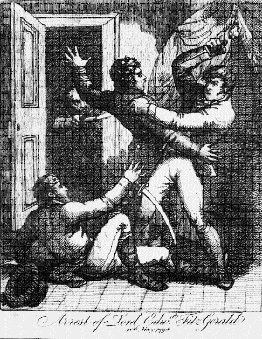
Arrest of Lord Edward Fitzgerald after James Dowling Herbert from The Irish Magazine, 1810. (National Library of Ireland)
In 1810, the radical journalist Watty Cox accompanied a lead article in his Irish Magazine on Lord Edward Fitzgerald with a crude yet dramatic woodcut of the famous arrest of the United Irishman on 18 May 1798. The woodcut conflates the events of Fitzgerald’s capture as they occurred at 135 Thomas Street, Dublin, the home of a feather merchant, Nicholas Murphy, so that we get all three of Fitzgerald’s captors in his room at the same time. Framed by his bed, Fitzgerald is heroised as a determined and robust figure. He dominates the scene as he thrusts his dagger into a terrified Captain Ryan, having already dealt with a wounded Major Swan who has fallen to the floor and is seen dropping his sword. In the background, Major Sirr fires the decisive shot from the doorway. Fitzgerald would eventually die from septicaemia caused by these gun shot wounds some two weeks later in his cell at Newgate gaol.
This ‘grand and interesting spectacle’ as Watty Cox described the woodcut, is tightly composed but is in fact a reduced reproduction of a grander image. The anonymous print is based on an oil painting produced within a few years of the event by the little known Dublin painter-cum-actor, James Dowling Herbert. At the end of his long panegyric to Lord Edward in The United Irishmen, their Lives and Times (1858), Richard Robert Madden, tells us of Herbert’s now lost canvas. Madden examined the picture while carrying out research for his history of the United Irishmen and laments its then dilapidated condition and how Herbert had been unable to profit from its production, most particularly in being unable to sell engravings after the original. The eventual woodcut that appeared in The Irish Magazine greatly reduces the scene depicted in the oil, for in the background, as Madden informs us, Herbert had included ‘a soldier…seizing Nicholas Murphy by the collar, and some military men in the act of rushing up the stairs’. The sorry fate of Herbert’s picture and its legacy in the form of a simplified woodcut, contrast greatly with the history of other images of Fitzgerald which have received more careful handling.
Portrait as historical source
Madden’s mid-nineteenth-century account of his hero is prefaced by an engraving by T.W. Huffam after a miniature portrait by Horace Hone (overleaf). Numerous engraved portraits of United Irishmen were included by Madden so as to increase the emotional impact of his study. The title pages of the various volumes draw our attention to these ‘original portraits’ which are given equal billing with the ‘additional authentic documents’. The implication is that portraits are a useful source for the study of 1798 and as such an examination of how Fitzgerald was represented may inform us on the political role of the visual in the 1790s.
Hone’s portrait of Fitzgerald, a version of which was painted in water-colour in 1797, is contemporaneous with a much larger portrait in oils of Fitzgerald by the more celebrated artist, Hugh Douglas Hamilton (front cover). The pose, dress and appearance of Fitzgerald in both Hone and Hamilton’s representations are puzzlingly similar. Fitzgerald may have sat for both and asked for the same depiction or as is more likely, Hone was requested to repeat Hamilton’s original portrait on a smaller scale. The upshot of all this is a surprisingly large amount of portraits of Lord Edward Fitzgerald. Hone’s miniature portrait has at least seven variants while Hamilton’s three-quarter-length oil portrait was reduced to at least another seven head and shoulder versions (opposite page). Why did so many portraits of the United Irishman appear in the final years of the eighteenth century and is there more to these images than a mere likeness of a much admired leader?
A spirited likeness
Turning first to Hamilton’s three-quarter-length portrait of Fitzgerald (front cover), this canvas is the seminal image for all later variants. The United Irishman, William Drennan, saw it in Hamilton’s studio in Clare Street, Dublin in November 1797 and thought it ‘very spirited’. He was more critical of two portraits of Fitzgerald’s wife, Lady Pamela, ‘in one likeness, or rather sketch…, as a Medusa, with snakes round her head and falling on her bosom. I think it ill-judged, though Medusa was a fair lady. Perhaps it was a vagary of the painters’. More recently, Stella Tillyard has referred to Hamilton’s portrait of Lord Edward as ‘innocuous’. Indeed, the draped column and three-quarter view of the face are standard features of late eighteenth-century portraiture as is the folded paper on the right which here reads ‘Rt Hon/Lord Edward Fitzgerald/ Dublin’. This inscription implies that there is no dropping here of the sitter’s honorary title as son of a duke or of his status as an MP, which might date the commencement of the portrait to late 1796 and early 1797, the last session of the Irish Parliament in which Fitzgerald sat as member for County Kildare.
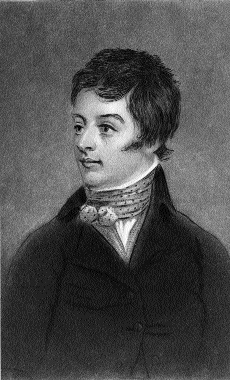
Lord Edward Fitzgerald by T.W. Huffam after Horace Hone, from R.R. Madden’s United Irishmen (National Gallery of Ireland)
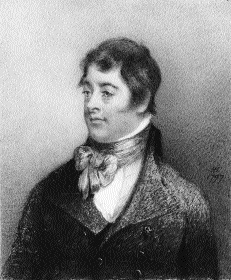
Lord Edward Fitzgerald by T.W. Huffam, 1797 original by Hone. (National Gallery of Ireland)
And yet, despite such traditional visual language, Fitzgerald subtly subverts the genre of respectable portraiture by a number of gentle inclusions. He is dressed in a cut-away blue coat and buff trousers, the dress and colours of the English opposition, the Foxite Whigs. To that is added a red French cravat while his hair, cut democratically short, is combed forward in the French-style over the temples. The elegant arm akimbo is another common feature of male portraiture of the period as is the draped column but the red cloth that follows the flow of Fitzgerald’s body and is forced on our attention by the opening of his arms is a provocative visual echo of his red necktie, possibly reminding us of the demotic association that the colour red had in revolutionary France.
The colour green
Fitzgerald sat for Hamilton sometime between 1796 and 1797. The artist went on to adapt the three-quarter-length to head and shoulder size. In some versions of these reduced portraits, the sitter wears a green jacket, a sartorial choice that also appears in a number of contemporaneous miniatures by Horace Hone. Just as the French spent much of the 1790s arguing over official revolutionary costume, so too the United Irishmen as Nancy Curtin has written, ‘developed a symbology which was exploited for propagandist purposes as well’. Theirs was the first official appropriation of the colour green as emblematic of the national cause. Within a short time of his being painted by Hamilton, Fitzgerald had a suitable commander’s uniform designed which incorporated Irish green for the jacket and braiding of revolutionary red, an outfit that was seen by Dublin Castle as being ‘manifestly French’.
Fitzgerald personally sat for Hamilton and Hone but the vast majority of imagery associated with him is posthumous. The ensuing production of portraits of a dead subject adds an extra nuance to the examination of these variants. In fact these later images can be viewed as part of the creation of a cult, a cult fostered by the Fitzgerald family, distraught at the death of a favourite son and sibling. The United Irishman’s sister, Lady Lucy Fitzgerald, lost no time after the death of her brother in dispatching a portrait to Fitzgerald’s old friend and political mentor, Thomas Paine. And yet, it could also be argued that Fitzgerald initiated this cult of himself by having his portrait painted by Hamilton with the intention of presenting it to his mother who had for some time before his death been collecting, as Tillyard has informed us, ‘memories and objects to remind herself of him’. In time, engravings were made after the Hone and the Hamilton portraits. As mentioned, Huffam’s engraving after Hone was used by Madden while some years earlier in 1831, Thomas Moore had used an engraving by T.A. Dean after Hamilton, as a frontispiece for his biography of Fitzgerald. The availability of such images, not just within the covers of leather bound books but also, presumably, in Dublin print shops, helped to form the creation of the image of a nationalist icon.
Romantic innocent
Moore used emotive family letters to inform us of the various copies being produced by Hamilton and his studio. In one letter, written within days of Fitzgerald’s death, his aunt tells his brother that
I have got the watch and chain that hung constantly round his neck, with a locket of hair, which I will send you by the first opportunity, along with his own dear hair. I have been with Hamilton the painter. There are two pictures of him, one for your mother and the other for you, besides one of Lucy, I believe for you also. Mr Hamilton says they are not finished and cannot be ready to go to England these three months; but he will hasten them as much as possible, and I will take care to forward them.
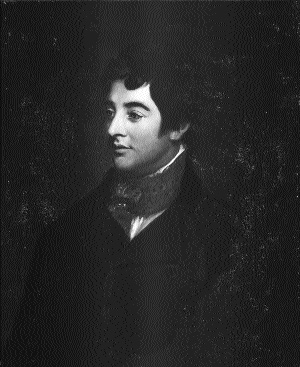
Lord Edward Fitzgerald (1797-8) by Hugh Douglas Hamilton. (Ulster Museum)
These two copies soon grew to at least seven, most of which seem to have been made for members of the large Fitzgerald family. In examining these paintings, it is clear that shortly after his death small changes began to occur in Fitzgerald’s iconography. The red necktie and green jacket seen in the earlier variations on the original three-quarter-length, disappear in the numerous, posthumous portraits and are replaced by a necktie of an inoffensive white and a black jacket. This visual dilution of the image of the radical Fitzgerald runs in tandem with his gradual popular and historical transformation from impressive political and military strategist to a tragic yet romantic innocent.
Hamilton and Hone’s portraits were produced in Dublin but the visualisation of Edward Fitzgerald was also available to a London audience. The difference is that by the time this happened he was dead. For at least a year after his death, Fitzgerald’s name and representation appeared in a number of London-based satires as synonymous with radicalism but also with lost opportunities. Charles James Fox is frequently the one who has lost out, both politically, in the defeat of the republican cause and personally, in the loss of a cousin. On 11 June, a week after Fitzgerald’s death, Fores of Piccadilly published ‘Tears of Sensibility…The Whig Club in Distress’ where Fox and his friends shed tears and sigh ‘Poor Neddy’. Fox exclaims, ‘O Dear Lord Edward Fitzgerald, the Worthiest, the truest, most hot hearted, the bravest, the best of us All, the most, like myself, and whoever feels for him must feel for me also’. It is James Gillray though who can be accredited with one of the earliest visualisations of that subtle change of emphasis that effected the transformation of Fitzgerald from rebel to victim. The well known print, ‘Nightly Visitors at St Ann’s Hill’ of September 1798 shows Fox at home in bed, with a bonnet rouge on his head, being visited by a Banquo-like apparition of six recently deceased United Irishmen. The blood-stained figure of Fitzgerald accuses him of seducing ‘my youthful Mind from Virtue/Who plann’d my Treasons, & who caus’d my Death?/Remember poor Lord Edward and despair!!!’.
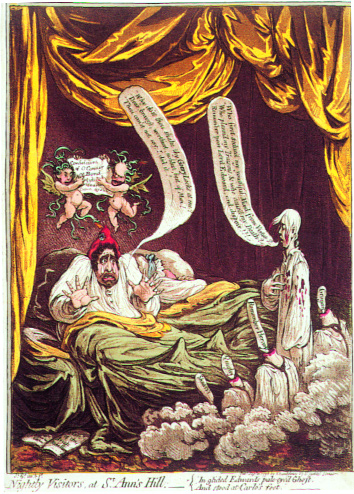
Nightly Visitors, at St Ann’s Hill (1798) by James Gillray. (British Museum)
The other headless bodies represent the executed Cornelius Grogan, the Revd. James Coigly (sometimes Quigley), the Sheares brothers and Bagenal Harvey. Fox echoes Macbeth in his denials, ‘Why do’st thou shake thy Goary Locks at me?…Thou can’st say, I did it!’ But an open book on the ground by his bed reads ‘Plan of the Irish Rebellion’.
Fitzgerald’s legacy
The sad state of Herbert’s painting of Fitzgerald’s ‘Arrest’ as described by Madden in the mid-nineteenth century and the failure to produce engravings of the image tell us of the difficulty in disseminating nationalist imagery in the immediate aftermath of 1798. The many portraits of Lord Edward were a different matter as they all began life as private commissions from a high aristocratic family and as such, initially, had limited visibility outside the Fitzgerald circle. Madden’s complaint over the failure of Herbert’s image to be adequately appreciated ends with a call on the public bodies of Ireland to exhibit ‘sufficient patriotism to secure [Herbert’s] representation of the mortal conflict wherein the noblest being that Ireland ever produced received his death wounds’. Such a call on the nation’s conscience echoes Thomas Davis’s contemporaneous complaint that ‘We have Irish artists, but no Irish, no national art’. Davis went on to supply a list of historical subjects accompanied by suitable textual sources for the creation of such a national art. The topics ranged from ‘The Landing of the Milesians’ as told by Geoffrey Keating and by Thomas Moore in his Melodies to 1798 itself. The United Irish movement in general received some seven hints for subjects, for example, Wolfe Tone meeting with Lazare Carnot of the French directory and the United Irish victory at Oulart Hill. But Fitzgerald’s arrest did not feature, doubtless it was too negative an event. All of Davis’s 1798 themes are celebratory directing one to stirring positive moments in the pursuit of nationhood.
As with the representation of Fitzgerald’s arrest, so too Hamilton’s and Hone’s portraits of Fitzgerald do not fit Davis’s blue print for an obvious ‘national art’. But this is not to dismiss them as the eccentricity of a family cult. By closely examining the appearance of the portraits, their changes in scale as well as their variations in costume and by looking at their eventual use, firstly as family mementoes and then as iconic images heralded by hagiographers such as Moore and Madden, it can be argued that these portraits of Fitzgerald, played a not insignificant role in the formation of nationalist opinion. In the 1790s, Hamilton and Hone created images of a determined young rebel, his thick dark hair brushed forward over a youthful fleshy face, an image that even the fiercely anti-radical cartoonist, Gillray, felt inclined to maintain.
Fintan Cullen is a Lecturer in Art History at the University of Nottingham.
Further reading:
T. Moore, The Life and Death of Lord Edward Fitzgerald, 2 vols. (London 1831).
R.R. Madden, The United Irishmen, Their Lives and Times, 4 vols. (Dublin 1857-60).
F. Cullen, ‘The Oil Paintings of Hugh Douglas Hamilton’, The Walpole Society (1984).
S. Tillyard, Citizen Lord: Edward Fitzgerald 1763-1798 (London 1997).
















